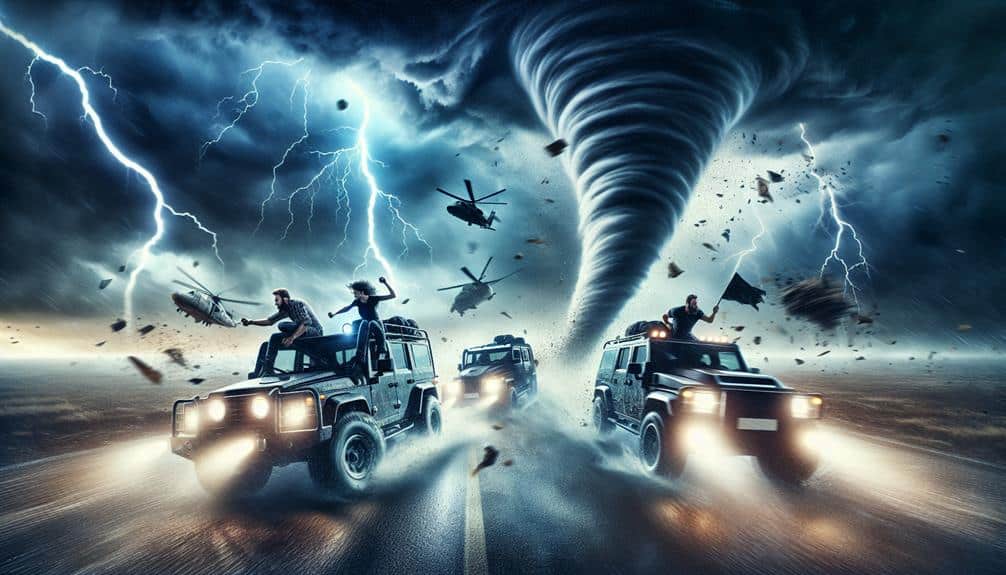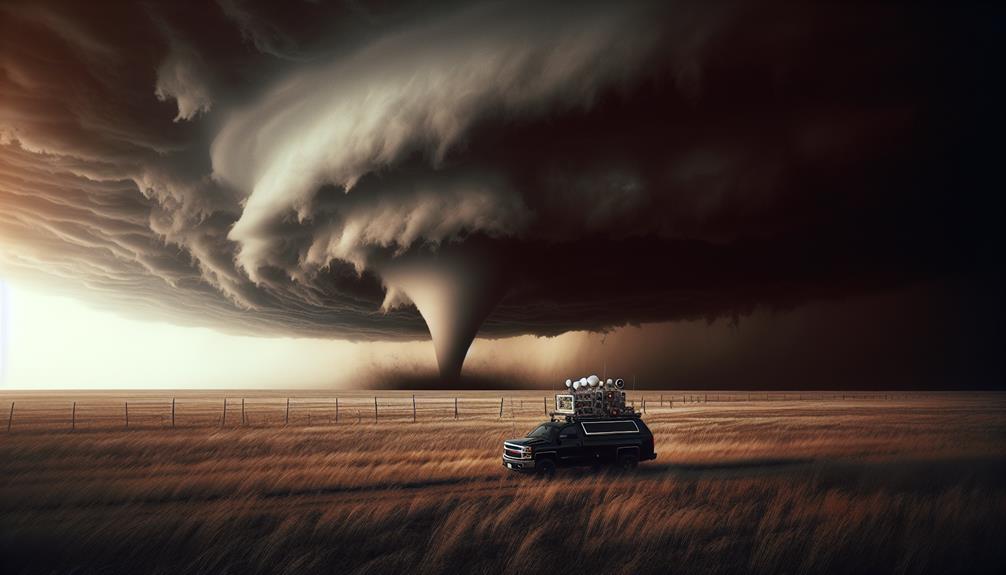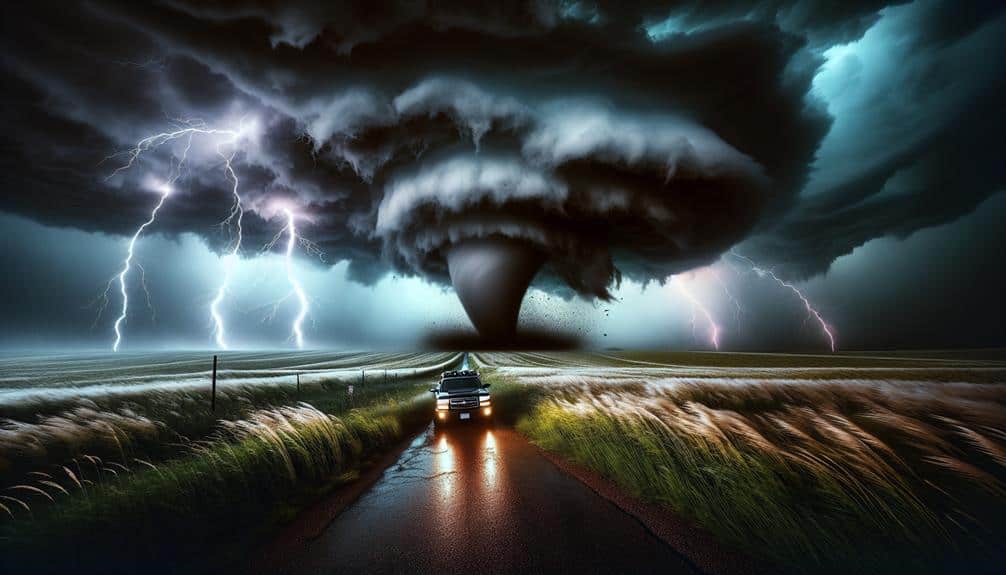Exploring the risks and rewards of storm chasing involves a deep understanding of meteorological principles and constant adherence to safety protocols. We utilize high-resolution cameras, anemometers, and GPS devices to capture valuable data, while reinforced vehicles and weatherproof gear are essential for safety. Risks like tornadoes with winds over 300 mph and lightning strikes reaching 30,000 Kelvin highlight the need for real-time data monitoring and robust contingency plans. While the adrenaline rush from chasing supercells is unmatched, meticulous documentation and collaboration with meteorologists enhance our comprehension of these phenomena. Let's delve further into balancing these thrilling yet hazardous pursuits.
Key Points
- Safety Precautions: Adhering to stringent safety measures and real-time weather updates is crucial for minimizing risks during storm chasing.
- Meteorological Knowledge: A deep understanding of atmospheric dynamics and storm forecasting enhances both safety and observational success.
- Essential Equipment: High-resolution cameras, GPS devices, and portable weather stations are vital for capturing data and ensuring safety.
- Collaborative Efforts: Working with meteorologists and local authorities improves forecasting accuracy and enhances overall safety.
Understanding Storm Chasing
Storm chasing, the pursuit of observing and documenting severe weather phenomena, requires a deep understanding of meteorological principles and atmospheric dynamics. To truly grasp the complexities of storm chasing, we must explore the critical aspects of safety precautions and risk management. Our primary goal is to mitigate potential hazards while maximizing observational opportunities. This involves constant vigilance and adherence to established safety protocols, including maintaining safe distances from storms and having multiple escape routes planned.
Researching storms and forecasting trends are pivotal in our approach. By analyzing historical weather data and current atmospheric conditions, we can predict storm formations with greater accuracy. This predictive capability allows us to position ourselves strategically, reducing unnecessary risks. We rely on advanced meteorological tools such as Doppler radar and satellite imagery to track storm developments in real time.
Understanding the inherent risks requires a commitment to continuous learning and adaptation. We must stay informed about the latest advancements in meteorology and storm behavior. This knowledge empowers us to make informed decisions, ensuring our safety while embracing the freedom to explore nature's most powerful phenomena.
As storm chasers, we blend scientific rigor with an insatiable curiosity, navigating the delicate balance between risk and reward.
Equipment and Preparation
Efficient storm chasing demands that we meticulously prepare and equip ourselves with the latest technology and reliable gear. Our gear essentials include high-resolution cameras, anemometers, GPS devices, and portable weather stations to monitor atmospheric conditions in real-time. We also rely on Doppler radar apps and satellite imagery for accurate storm tracking.
Safety precautions are paramount. We must wear sturdy, weatherproof clothing and helmets. Our vehicles are fortified to withstand severe weather, equipped with reinforced windows and storm cages. First aid kits, fire extinguishers, and emergency flares are non-negotiable essentials.
Effective communication strategies are vital. We use two-way radios, satellite phones, and mobile hotspots to maintain constant communication with our team and emergency services. This ensures that we can relay our location and status instantaneously, essential for a timely emergency response. Pre-established check-in intervals keep everyone updated and safe.
Data-driven decision-making guides our every move. We analyze meteorological data and model outputs to predict storm behavior accurately. This preparation, coupled with our gear essentials and safety precautions, allows us to navigate the inherent risks of storm chasing while maximizing the rewards of capturing nature's most awe-inspiring phenomena.
The Thrill of the Chase
When we engage in storm chasing, the adrenaline surge is unparalleled, driven by precise meteorological data and real-time analysis.
Our close encounters with supercells and tornadoes provide valuable observational data that enhance our understanding of severe weather phenomena.
Capturing high-resolution imagery of nature's fury not only satisfies our scientific curiosity but also contributes to public safety and awareness.
Adrenaline-Pumping Experiences
Few experiences can match the adrenaline surge we feel as we race toward the heart of a supercell thunderstorm, equipped with cutting-edge meteorological instruments. The thrill seeking aspect of storm chasing is undeniably exhilarating, but maintaining a balance between this excitement and stringent safety precautions is vital.
We conduct thorough risk assessments before each expedition, analyzing CAPE (Convective Available Potential Energy) values, wind shear data, and radar imagery to predict storm behavior accurately.
While the adrenaline rush propels us forward, our focus remains on maintaining a calculated approach. We rely on advanced Doppler radar systems and GPS tracking to stay informed of the storm's path, ensuring we steer clear of the most perilous zones.
Communication plays a significant role; real-time updates from National Weather Service alerts and fellow chasers keep us informed of any sudden changes in storm dynamics.
Our vehicles are reinforced with fortified glass and bodywork to withstand hail and strong winds. We carry emergency supplies, including first aid kits, satellite phones, and backup power sources, prepared for any unforeseen circumstances.
Close Encounters
As we edge closer to the storm's core, the raw power of nature becomes palpable, driving our anticipation and focus to unparalleled levels. The atmospheric pressure drops, wind speeds escalate, and our Doppler radar indicates the mesocyclone's rotation intensifying. These are the moments we live for, despite the inherent chasing dangers.
Our vehicle's anemometer registers gusts surpassing 70 mph, and we can actually feel the vehicle sway. It's a calculated risk, but the data we collect during these close encounters is invaluable for understanding storm dynamics.
The thrill of seeing a funnel cloud form, knowing we're witnessing the birth of a tornado, is a scientific marvel and an unforgettable moment.
Yet, we must remain vigilant. Flash flooding, hailstones the size of baseballs, and lightning strikes are ever-present threats. Our GPS and real-time data feed are our lifelines, allowing us to navigate these perils with precision.
The beauty of storm chasing lies in this balance—embracing the freedom to explore nature's fury while respecting its formidable power. Each chase is a blend of science and survival, giving us stories and data that few others will ever experience.
Capturing Nature's Fury
Capturing nature's rage through high-definition cameras and advanced meteorological tools allows us to document and analyze the intricate details of storm genesis and development. By understanding these powerful events, we gain valuable insights into atmospheric dynamics and potential hazard reduction.
Our primary concern during storm chasing is safety. We always establish a strong set of safety measures, including real-time weather updates, GPS tracking, and maintaining a safe distance from the storm's core. This ensures that while we capture stunning images, we remain out of harm's path.
Photography tips are essential for effectively capturing these moments. We use DSLR cameras with wide-angle lenses to encompass the vast cloud formations. High shutter speeds are necessary to freeze lightning strikes, while tripods stabilize our shots against turbulent winds. Additionally, bracketing exposures helps us achieve a balanced shot despite varying light conditions.
We also integrate meteorological instruments like anemometers and barometers to record wind speeds and atmospheric pressure changes. This data, synchronized with our visual documentation, offers a complete view of the storm's behavior.
Our balanced approach of blending scientific rigor with the freedom of exploration allows us to truly capture and understand nature's rage.
Potential Hazards Faced
When we're in the field, we face severe weather conditions that can rapidly change, posing threats like tornadoes, lightning, and flash flooding. Our equipment isn't immune to these elements either, often malfunctioning under extreme conditions.
These hazards require us to employ real-time data analysis and robust contingency plans to guarantee our safety.
Severe Weather Conditions
Storm chasers frequently encounter severe weather conditions, including tornadoes, lightning, and hail, each presenting unique hazards that require precise monitoring and swift decision-making. It's critical we implement rigorous safety precautions when pursuing extreme weather.
Tornadoes, with wind speeds exceeding 300 mph, demand constant vigilance and a thorough understanding of their unpredictable nature. We must continually assess the risk to reposition ourselves safely while maintaining prime storm spotting locations.
Lightning strikes, which can reach temperatures of 30,000 Kelvin, pose a significant threat. We mitigate this by avoiding open fields, metal objects, and tall structures, although the danger remains omnipresent. The risk assessment process involves real-time analysis of radar data and electrical activity to predict potential strike zones.
Hail, often exceeding diameters of 4 inches, can cause severe damage to vehicles and equipment. Our strategy includes monitoring storm cell development and using reinforced vehicles to withstand impacts. By employing sophisticated meteorological tools and maintaining an agile response strategy, we aim to minimize the inherent risks.
The thrill of storm chasing aligns with our commitment to freedom, but it's our meticulous approach to safety that guarantees we live to chase another day.
Equipment Malfunctions
Our storm-chasing endeavors are often jeopardized by equipment malfunctions, which can compromise data integrity and jeopardize safety. High-resolution cameras, anemometers, and GPS systems are critical for collecting data and navigating volatile environments. However, these devices are susceptible to technical difficulties, particularly in severe weather conditions.
A malfunctioning anemometer can give erroneous wind speed readings, leading to misjudged distances from the storm's core. Similarly, a GPS failure can leave us disoriented, increasing the risk of encountering unforeseen hazards.
To mitigate these risks, implementing stringent safety measures is essential. Regular maintenance and pre-chase equipment checks are fundamental to ensure operational integrity. Backup systems, such as secondary GPS units and redundant communication devices, offer additional layers of security.
For instance, if our primary GPS fails, a secondary unit can immediately take over, preventing disorientation and enhancing our ability to make timely decisions.
Moreover, real-time data monitoring allows us to identify and address equipment malfunctions promptly. By using telemetry systems to relay equipment status back to a central hub, we can detect anomalies and execute corrective actions swiftly. These proactive measures not only safeguard our lives but also guarantee the reliability of our collected data, empowering us to chase storms with confidence and precision.
Documenting the Experience

Capturing high-resolution imagery and real-time data is essential for accurately documenting the storm chasing experience. Utilizing advanced cameras with high frame rates and drones equipped with meteorological sensors, we can gather detailed visual and atmospheric data. These tools enable us to not only observe but also analyze storm patterns with scientific precision.
Applying artistic perspectives and storytelling techniques, we transform raw data into compelling narratives. By integrating time-lapse photography and dramatic videography, we can illustrate the dynamic beauty and intensity of storms. This approach allows us to convey the emotional and visual impact of our experiences, engaging viewers on a deeper level.
To reach a broad audience, we leverage social media and online platforms. By sharing real-time updates and live streams, we provide an immersive experience for our followers. Platforms like Instagram and YouTube allow us to distribute our content widely, while specialized forums and meteorological websites enable us to connect with fellow enthusiasts and experts.
Through meticulous documentation, we not only enhance our understanding of severe weather phenomena but also inspire others to appreciate the power and beauty of nature. Our dedication to capturing and sharing these experiences underscores the importance of freedom in exploration and discovery.
Learning From Storm Chasers
Learning from experienced storm chasers offers valuable insights into the methodologies and strategies necessary for safely and effectively tracking severe weather events. By analyzing their techniques, we can adopt best practices and enhance our own storm-chasing endeavors.
First and foremost, safety measures are essential. Experienced storm chasers stress the importance of maintaining a safe distance from tornadoes and other hazardous weather phenomena. They utilize advanced meteorological tools, such as Doppler radar and satellite imagery, to monitor storm development in real-time. This data-driven approach allows us to anticipate storm movements and avoid risky situations.
Expert advice also highlights the importance of having a well-prepared emergency kit. This includes first-aid supplies, water, non-perishable food, and communication devices like radios and satellite phones. By being prepared, we make sure that we can handle unforeseen scenarios.
Furthermore, seasoned chasers often collaborate with meteorologists and local authorities, providing valuable data for weather forecasting and public safety. This collaboration not only enhances our understanding of severe weather patterns but also contributes to community safety.
Frequently Asked Questions
How Do Storm Chasers Coordinate With Local Emergency Services and Meteorologists?
We coordinate with local emergency services and meteorologists through established communication protocols and safety precautions. Real-time data sharing and strategic positioning guarantee accurate updates and proactive measures, maximizing our operational efficiency while maintaining public safety and freedom.
What Qualifications Are Needed to Become a Professional Storm Chaser?
'Rome wasn't built in a day.' To become a professional storm chaser, we need rigorous training requirements and substantial experience levels. This includes meteorological education, safety protocols, and field experience to guarantee precise, effective storm tracking and data collection.
Are There Specific Regions More Popular or Safer for Storm Chasing?
We often prioritize popular regions like Tornado Alley due to their high storm frequency. Safety factors, including terrain and infrastructure, greatly influence our decisions, ensuring we can chase responsibly while minimizing risks to ourselves and others.
How Do Storm Chasers Contribute to Scientific Research and Public Safety?
We collect invaluable data, enhancing forecasting models. Our training and preparedness efforts improve public safety by providing real-time updates. Through meticulous data collection, we help refine predictive algorithms, ensuring communities have the freedom to prepare effectively.
What Are the Legal Considerations and Permits Required for Storm Chasing?
We'd need mountains of paperwork, including permit requirements, to chase storms legally. Legal considerations encompass respecting private property, following traffic laws, and guaranteeing compliance with local regulations to avoid hefty fines and secure public safety.


